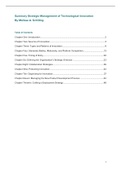Summary Strategic Management of Technological Innovation
By Melissa A. Schilling
Table of Contents
Chapter One: Introduction ............................................................................................................................. 2
Chapter Two: Sources of Innovation........................................................................................................... 3
Chapter Three: Types and Patterns of Innovation .................................................................................. 9
Chapter Four: Standards Battles, Modularity, and Platform Competition ........................................ 13
Chapter Five: Timing of Entry ..................................................................................................................... 20
Chapter Six: Defining the Organization’s Strategic Direction ............................................................23
Chapter Eight: Collaboration Strategies.................................................................................................. 26
Chapter Nine: Protecting Innovation .........................................................................................................32
Chapter Ten: Organizing for Innovation ................................................................................................... 37
Chapter Eleven: Managing the New Product Development Process ..............................................42
Chapter Thirteen: Crafting a Deployment Strategy ..............................................................................48
1
,Chapter One: Introduction
The importance of technological innovation
® Technological innovation = the act of introducing a new device, method, or material for
application to commercial or practical objectives.
In many industries, technological innovation is now the most important driver of competitive
success. Firms in a wide range of industries rely on products developed within the past five
years for almost one-third (or more) of their sales and profits.
The increasing importance of innovation is due in part to the globalization of markets. Foreign
competition has put pressure on firms to continuously innovate in order to produce differenti-
ated products and services. Introducing new products helps firms protect their margins, while
investing in process innovation helps firms lower their costs. Advances in information technol-
ogy also have played a role in speeding the pace of innovation. Computer-aided design and
manufacturing have made it easier and faster for firms to design and produces new products,
while flexible manufacturing technologies have made shorter production runs economical and
have reduced the importance of production economies of scale.
Product life cycles have become as short as 4 to 12 months for software, 12 to 24 months for
computer hardware and consumer electronics, and 18 to 36 months for large home appliances.
This spurs firms to focus increasingly on innovation as a strategic imperative – a firm that does
not innovate quickly finds its margins diminishing as its products become obsolete.
The impact of technological innovation on society
® Gross domestic product (GDP) = the total annual output of an economy as measured
by its final purchase price.
The aggregate impact of technological innovation can be observed by looking at gross domes-
tic product (GDP). The average world GDP per capita has risen steadily since 1980. Techno-
logical innovation increased the amount of output achievable from a given quantity of labor and
capital. While GDP has its shortcomings as a measure of standard of living, it does relate very
directly to the amount of goods consumers can purchase. Thus, to the extent that goods im-
prove quality of life, we can ascribe some beneficial impact of technological innovation.
® Externalities = costs (or benefits) that are borne (or reaped) by individuals other than
those responsible for creating them.
Sometimes technological innovation results in negative externalities. However, technology is,
in its purest essence, knowledge – knowledge to solve our problems and pursue our goals.
Technological innovation is thus the creation of new knowledge that is applied to practical
problems.
2
,Innovation by industry: The importance of strategy
While innovation is popularly depicted as a freewheeling process that is unconstrained by rules
and plans, study after study has revealed that successful innovators have clearly defined inno-
vation strategies and management processes.
The innovation funnel
Only about one in nine projects that are initiated is successful, and of those that make it to the
point of being launched to the market, only about half earn a profit. It takes about 3,000 raw
ideas to produce one significantly new and successful commercial product. The innovation pro-
cess is thus often conceived of as a funnel, with many potential new product ideas going in the
wide end, but very few making it through the development process.
Chapter Two: Sources of Innovation
Overview
® Innovation = the practical implementation of an idea into a new device or process.
Innovation can arise from many different sources. One primary engine of innovation is firms.
Firms are well suited to innovation activities because they typically have greater resources than
individuals and a management system to marshal those resources toward a collective purpose.
Firms also face strong incentives to develop differentiating new products and services, which
may give them an advantage over nonprofit or govern-
ment-funded entities.
An even more important source of innovation is the link-
age between different sources, like firms, individuals, uni-
versities, private nonprofits and government-funded re-
search.
Creativity
® Idea = something imagined or pictured in the mind.
® Creativity = the ability to produce novel and useful work.
Innovation begins with the generation of new ideas. The ability to generate new and useful
ideas is termed creativity. The most creative works are novel at the individual producer, local
audience and the broader societal level.
Individual creativity
An individual’s creative ability is a function of his or her intellectual abilities, knowledge, per-
sonality, motivation and environment.
3
, • The most important intellectual abilities for creative thinking include intelligence,
memory, the ability to look at problems in unconventional ways, the ability to analyze
which ideas are worth pursuing and which are not, and the ability to articulate those
ideas to others and convince others that the ideas are worthwhile.
o Primary process thinking – ability to let their mind engage in a visual mental
activity.
o Remote associations or divergent thinking – combining ideas that are not typi-
cally related. Which can result from primary process thinking.
• Highly creative people’s speed of association is due to exceptional working memory
and executive control. In other words, the ability to hold many thinks in one’s mind sim-
ultaneously and maneuver them with great facileness enables a person to rapidly ex-
plore many possible associations.
• An individual with only a moderate degree of knowledge (not too little or much) of a
field might be able to produce more creative solutions, breakthrough innovations are
often developed by outsiders to a field. Outsiders often face resistance and skepticism.
• The personality trait most often associated with creativity is “openness to experience”.
This reflects an individual’s use of active imagination, aesthetic sensitivity, attentiveness
to emotion, a preference for variety, and intellectual curiosity.
• Intrinsic motivation has also been shown to be very important for creativity. Individuals
are more likely to be creative if they work on things they are genuinely interested in and
enjoy.
• To fully unleash an individual’s creative potential usually requires a supportive environ-
ment with time for the individual to explore their ideas independently, tolerance for un-
orthodox ideas, a structure that is not overly rigid or hierarchical, and decision norms
that do not require consensus.
Organizational creativity
The creativity of the organization is a function of creativity of the individuals within the organi-
zation and a variety of social processes and contextual factors that shape the way those indi-
viduals interact and behave. The organization’s structure, routines, and incentives could thwart
individual creativity or amplify it.
® Intranet = a private network, accessible only to authorized individuals. It is like the In-
ternet but operates only within (“intra”) the organization.
The most familiar method of a company tapping the creativity of its individual employees is the
suggestion box, where the originators of adapted ideas were awarded. There are also more
elaborate systems that non only capture employee ideas but incorporate mechanisms for se-
lecting and implementing those ideas. For example, employees access the company’s idea
repository through the company’s intranet. There they can submit their ideas and actively in-
teract and collaborate on the ideas of others. Through active exchange, the employees can
4






